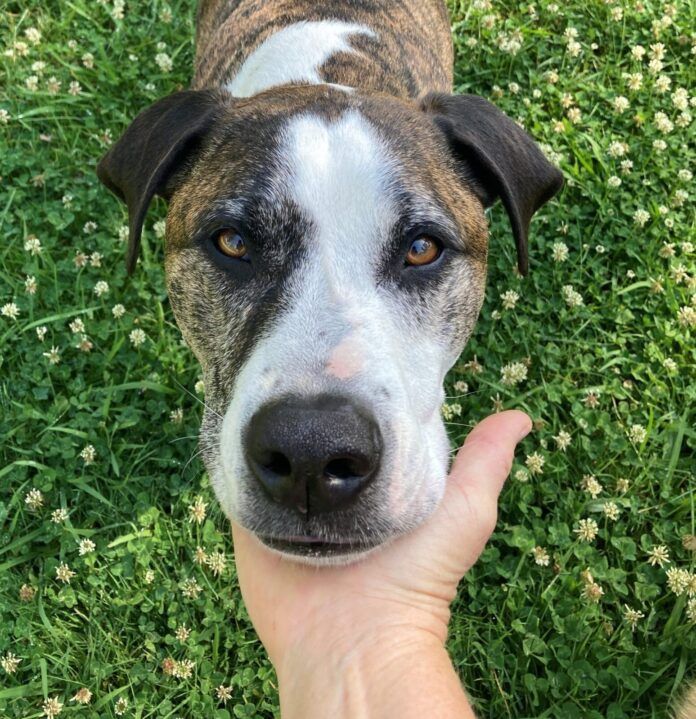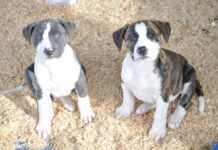I’ve taught both of my grown-up dogs several positions where they will be rewarded for holding still while I – or, importantly, a stranger such as a vet or vet tech – examines them. They both will lay flat and hold still, or stand and do a “chin rest” (where they press their chin in my hand) and hold still. But the desired behavior is not just “remaining still no matter what”; the “cooperative care” piece of this behavior is a sort of deal: they hold still so that I (or someone else) can touch and examine them, but if they lift their heads, the touching and/or exam must stop immediately. It’s the “deal” you make with them, and what I – like most people who teach this behavior – have found, is that once they learn that they have control over the procedure – they can stop the exam at any moment by lifting their head – they feel more confident about going along with it.
We explained and showed you how to teach cooperative care behaviors in “Cooperative Care: Giving Your Dog Choice and Control” (WDJ February 2021).
However, I’ve been remiss in working with Boone, the name we’ve finally given to the “foster puppy” who has been here since early March. (I guess this is also an adoption announcement!) Something I’ve observed about him since he’s been here: He hates people looking at his teeth!
Checking a puppy’s teeth before he’s 6 months old is the best way to estimate his age, as the “puppy teeth” all start falling out when the pup is around 4 months old, are usually all gone by about 5 months, and have all newly erupted incisors (the little front teeth), canines (the “fangs”), and premolars (the ones just behind the canines) by about 7 months. (The molars generally take a little longer to erupt, but this varies a lot by the size of the dog.)
Ever since was brought into my local shelter as a “stray,” people have been lifting his lips and trying to figure out his age. He was a lot larger and bigger-boned than the litter of 11 puppies that were brought into the shelter on the same day; the staff judged him to be about 8 weeks old, just based on size, but his demeanor and lack of coordination made him seem much younger. To try to get a better read on his age, shelter staff members (and I!) kept trying to look at his teeth – and he’d struggle every time! And every time, I’d say, “Oy! I have to work on that behavior!”
Now I’m paying the price for having not yet taken the time to work on it.

Yesterday, while wrestling and playing tug-of-war with Boone and Woody on our trampoline (a favorite place for this), I heard Boone screech when he and Woody’s mouths bumped as they jostled for the same toy. The next time in the game when he came to sit in my lap, I tried to gently put my hands on Boone’s muzzle, so I could try to see if he had something wrong – a wood splinter or plastic chunk stuck in his teeth, or a foxtail jammed in his gums, perhaps. He could even have a snake bite or something else really serious hiding under that adorable beard! But as I went to lift his lips, he screeched again and dodged away from me. Uh oh; something definitely wrong going on in there. Now I have to look, and we have no agreement or understanding about how this is going to get done.
This is one of those times when it would be easy to permanently damage my relationship with the pup, or advance his reluctance to have his mouth examined into full-scale aggressive resistance.
Instead, I spent more than an hour, in five-minute sessions over the course of the evening and well into the night, working with Boone to teach him a chin rest (that went very quickly – he got it almost immediately) and to hold that chin rest while I touched his upper lip. That made him a little frustrated, because he is very food-motivated, but he also does not want to tolerate any pressure on his upper lips at all.
As we practiced, I was able to determine that he didn’t have any obvious bite marks or wounds on the outside of his face, and given his ability to take treats and chew his dinner kibble, I surmised that he didn’t have anything seriously wrong with his mouth. I suspected – from our previous estimates of his age – that he lost one of those canines; it might have even been torn out during his raucous games of tug with Woody. So I didn’t push for a more complete exam.
But this morning, we went back to the drawing board, and after another half-dozen, several-minute sessions, I was finally able to get Boone to stay still and allow me to lift his upper lip enough to confirm my suspicion: He has a (relatively) big gaping hole where his top left canine used to be. The other canines are all still firmly in place, so he likely lost that one a little prematurely, leaving the gum very sensitive.
I’m glad that’s all it is – but I’m definitely going to commit to daily sessions of the cooperative care “Bucket Game” from here on out. I don’t want the next medical crisis to precipitate a behavioral one.







Wow, thanks to Nancy, great article on comfortably examining a dog’s mouth! Another plug for daily tooth-brushing – our 5 year old pup is already used to us messing with her mouth and teeth!
Congrats on the adoption. May Boone bring joy to all is you especially Woody.